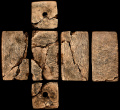Difference between revisions of "Kesh Temple Hymn"
| (One intermediate revision by the same user not shown) | |||
| Line 32: | Line 32: | ||
[[Category: Books]] | [[Category: Books]] | ||
| − | [[Category: | + | [[Category: Writing Genre - Poetry]] |
[[Category: Songs]] | [[Category: Songs]] | ||
[[Category: Hymns]] | [[Category: Hymns]] | ||
| Line 39: | Line 39: | ||
[[Category: Books I've Read]] | [[Category: Books I've Read]] | ||
[[Category: Public Domain]] | [[Category: Public Domain]] | ||
| + | [[Category: Poems I've Read]] | ||
Revision as of 10:49, 17 September 2020
The Kesh Temple Hymn is one of the oldest surviving examples of literature dating back to around 2600 BCE. The work is written as a Sumerian hymn and describes the Temple of Kesh.
Status
This song is in the public domain. I don't own a physical copy, but have read an English translation.
Review
Good
- It's interesting to see that the phrase "the four corners of the earth," or "heaven" in this case, has such an ancient history.
- The work is littered with animal similes showing just how big a role animals played in the lives of the authors.
Bad
- I find the format to be difficult to read. But then, I prefer prose over poetry.
- The work itself is dull. It just goes on and on describing a big building.
Ugly
- I understand that repetition is expected in this format, but how many times do they have to repeat the refrain, "Will anyone else bring forth something as great as Keš? Will any other mother ever give birth to someone as great as its hero Ašgi? Who has ever seen anyone as great as its lady Nintur?"
Media
Links
- etcsl.orinst.ox.ac.uk/cgi-bin/etcsl.cgi?text=t.4.80.2# - English translation.




